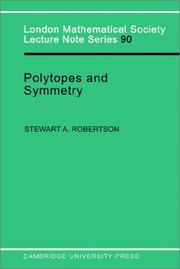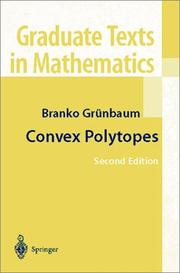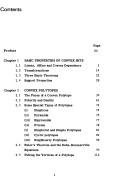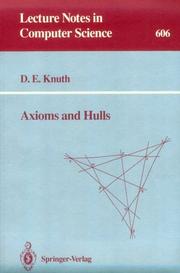| Listing 1 - 8 of 8 |
Sort by
|
Book
Year: 1967 Volume: 16 Publisher: London,New York : Interscience publishers, Division of John Wiley and sons,
Abstract | Keywords | Export | Availability | Bookmark
 Loading...
Loading...Choose an application
- Reference Manager
- EndNote
- RefWorks (Direct export to RefWorks)

ISBN: 0521277396 9780521277396 Year: 1984 Volume: 90 Publisher: Cambridge ; New York, NY : Cambridge University Press,
Abstract | Keywords | Export | Availability | Bookmark
 Loading...
Loading...Choose an application
- Reference Manager
- EndNote
- RefWorks (Direct export to RefWorks)
Convex polytopes --- Symmetry --- Polytopes convexes --- Symétrie --- Symétrie --- Geometrie --- Polyedres

ISBN: 9780387404097 9780387004242 0387404090 0387004246 9781461300199 1461300193 Year: 2003 Volume: 221 Publisher: New York : Springer,
Abstract | Keywords | Export | Availability | Bookmark
 Loading...
Loading...Choose an application
- Reference Manager
- EndNote
- RefWorks (Direct export to RefWorks)
"The appearance of Grünbaum's book Convex Polytopes in 1967 was a moment of grace to geometers and combinatorialists. The special spirit of the book is very much alive even in those chapters where the book's immense influence made them quickly obsolete. Some other chapters promise beautiful unexplored land for future research. The appearance of the new edition is going to be another moment of grace. Kaibel, Klee and Ziegler were able to update the convex polytope saga in a clear, accurate, lively, and inspired way." (Gil Kalai, The Hebrew University of Jerusalem) "The original book of Grünbaum has provided the central reference for work in this active area of mathematics for the past 35 years...I first consulted this book as a graduate student in 1967; yet, even today, I am surprised again and again by what I find there. It is an amazingly complete reference for work on this subject up to that time and continues to be a major influence on research to this day." (Louis J. Billera, Cornell University) "The original edition of Convex Polytopes inspired a whole generation of grateful workers in polytope theory. Without it, it is doubtful whether many of the subsequent advances in the subject would have been made. The many seeds it sowed have since grown into healthy trees, with vigorous branches and luxuriant foliage. It is good to see it in print once again." (Peter McMullen, University College London).
Convex polytopes --- Polytopes convexes --- Convex polytopes. --- Mathematics --- Physical Sciences & Mathematics --- Geometry --- Convex geometry . --- Discrete geometry. --- Convex and Discrete Geometry. --- Discrete mathematics --- Combinatorial geometry

ISBN: 038790722X 354090722X 1461270235 1461211484 9780387907222 Year: 1983 Volume: 90 Publisher: New York : Springer,
Abstract | Keywords | Export | Availability | Bookmark
 Loading...
Loading...Choose an application
- Reference Manager
- EndNote
- RefWorks (Direct export to RefWorks)
Geometry --- Convex polytopes --- Polytopes convexes --- Convex geometry --- Polyhedra --- Géométrie convexe --- Polyèdres --- Géométrie --- Géométrie convexe --- Polyèdres --- Géométrie

ISBN: 0521080177 9780521080170 Year: 1971 Volume: 3 Publisher: Cambridge ; New York, NY : Cambridge University Press,
Abstract | Keywords | Export | Availability | Bookmark
 Loading...
Loading...Choose an application
- Reference Manager
- EndNote
- RefWorks (Direct export to RefWorks)
Geometry --- Convex polytopes --- Polytopes convexes --- 514.17 --- Polytopes --- Convex sets. Geometric figure arrangements. Geometric inequalities --- Convex polytopes. --- 514.17 Convex sets. Geometric figure arrangements. Geometric inequalities --- Convex geometry --- Polyhedra --- Géométrie convexe --- Polyèdres --- Géométrie --- Géométrie convexe --- Polyèdres --- Géométrie

ISBN: 354094365X 038794365X 0387943293 3540943293 1461384311 Year: 1995 Volume: 152 Publisher: New York : Springer, 1995
Abstract | Keywords | Export | Availability | Bookmark
 Loading...
Loading...Choose an application
- Reference Manager
- EndNote
- RefWorks (Direct export to RefWorks)
Discrete mathematics --- Probability theory --- Polytopes --- Polytopes. --- 514.17 --- 514.17 Convex sets. Geometric figure arrangements. Geometric inequalities --- Convex sets. Geometric figure arrangements. Geometric inequalities --- Hyperspace --- Topology --- Geometry --- Convex polytopes --- Géométrie --- Polytopes convexes --- Convex geometry --- Polyhedra --- Géométrie convexe --- Polyèdres --- Géometrie combinatoire

ISBN: 3540556117 0387556117 3540472592 Year: 1992 Volume: 606 Publisher: Berlin : Springer-Verlag,
Abstract | Keywords | Export | Availability | Bookmark
 Loading...
Loading...Choose an application
- Reference Manager
- EndNote
- RefWorks (Direct export to RefWorks)
One way to advance the science of computational geometry is to make a comprehensive study of fundamental operations that are used in many different algorithms. This monograph attempts such an investigation in the case of two basic predicates: the counterclockwise relation pqr, which states that the circle through points (p, q, r) is traversed counterclockwise when we encounter the points in cyclic order p, q, r, p,...; and the incircle relation pqrs, which states that s lies inside that circle if pqr is true, or outside that circle if pqr is false. The author, Donald Knuth, is one of the greatest computer scientists of our time. A few years ago, he and some of his students were looking at amap that pinpointed the locations of about 100 cities. They asked, "Which ofthese cities are neighbors of each other?" They knew intuitively that some pairs of cities were neighbors and some were not; they wanted to find a formal mathematical characterization that would match their intuition.This monograph is the result.
Algorithmes --- Algorithms --- Algoritmen --- Convex polytopes --- Convexe polytopen --- Matroiden --- Matroides --- Matroids --- Polytopes convexes --- Matroïdes --- 519.1 --- Combinatorial designs and configurations --- Polytopes --- Algorism --- Algebra --- Arithmetic --- Combinatorics. Graph theory --- Foundations --- Algorithms. --- Convex polytopes. --- Matroids. --- 519.1 Combinatorics. Graph theory --- Matroïdes --- Information theory. --- Computer science. --- Computer graphics. --- Computer software. --- Combinatorics. --- Theory of Computation. --- Computer Applications. --- Discrete Mathematics. --- Computer Graphics. --- Algorithm Analysis and Problem Complexity. --- Combinatorics --- Mathematical analysis --- Software, Computer --- Computer systems --- Automatic drafting --- Graphic data processing --- Graphics, Computer --- Computer art --- Graphic arts --- Electronic data processing --- Engineering graphics --- Image processing --- Informatics --- Science --- Communication theory --- Communication --- Cybernetics --- Digital techniques
Book
Year: 2019 Publisher: MDPI - Multidisciplinary Digital Publishing Institute
Abstract | Keywords | Export | Availability | Bookmark
 Loading...
Loading...Choose an application
- Reference Manager
- EndNote
- RefWorks (Direct export to RefWorks)
This book contains the successful invited submissions to a Special Issue of Symmetry on the subject of ""Graph Theory"". Although symmetry has always played an important role in Graph Theory, in recent years, this role has increased significantly in several branches of this field, including but not limited to Gromov hyperbolic graphs, the metric dimension of graphs, domination theory, and topological indices. This Special Issue includes contributions addressing new results on these topics, both from a theoretical and an applied point of view.
Zagreb indices --- domination --- Devaney chaos --- rotationally-symmetric convex polytopes --- topologically mixing --- geometric arithmetic index --- connectivity --- Metric dimension --- atom-bond connectivity ABC index --- distinguishing number --- gear graph --- titanium difluoride --- algorithm --- generalized gear graph --- general Randi? index --- cuprite --- atom bond connectivity index --- binary locating-domination number --- basis --- hypercyclicity --- functigraph --- complete graph --- alpha-boron nanotube --- general randi? index --- geodesics --- inverse degree index --- Hex-Derived Cage networks --- metric dimension --- dominating set --- bipartite graphs --- products of graphs --- geometric-arithmetic GA index --- direct product of graphs --- gromov hyperbolicity --- secure resolving set and secure resolving domination --- topological indices --- graph operators --- resolving set --- harmonic index --- polycyclic aromatic hydrocarbons --- ILP models --- disjointness --- topological transitivity --- Gromov hyperbolicity --- metric basis --- harmonic polynomial
| Listing 1 - 8 of 8 |
Sort by
|

 Search
Search Feedback
Feedback About UniCat
About UniCat  Help
Help News
News